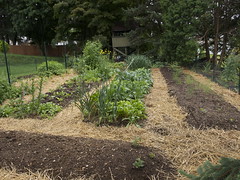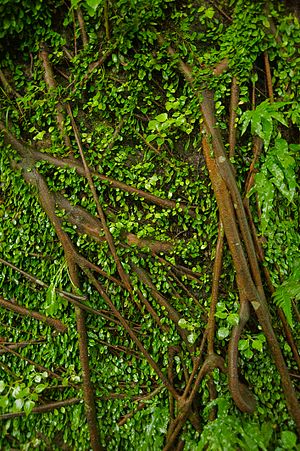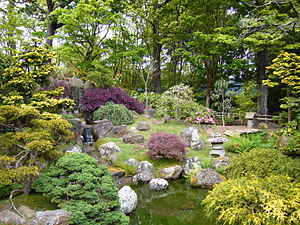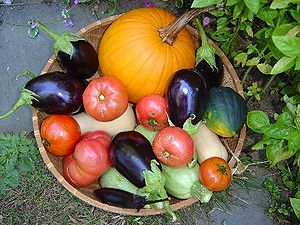We are continuing through our step-by-step guide to starting your own sustainable garden.
In this lesson, we are going to cover some helpful information about soil types, and preparing your garden soil for planting.
 Image via WikipediaIdentifying Types of Soil
Image via WikipediaIdentifying Types of SoilIf you’re getting ready to go on a new garden venture, you need to prepare your soil to ideally house your plants. The best thing you can do in the soil preparation process is to build the perfect mixture of sand, silt, and clay. Preferably (for most garden plant types) there would be 40 percent sand, 40 percent silt, and 20 percent clay.
Sand: Dirt primarily had its start from crumbled rock together with animal and vegetable decay. Friction from rocks colliding and grinding together, combined with great changes in temperature, and the water and the gases in the atmosphere helped in the crumbling process. From this action of mechanical rubbing, it is easy to understand how sand was formed. This represents one of the main divisions of soil.
However, if soil were nothing but broken rock masses then indeed it would be very poor and unproductive. But the early forms of animal and vegetable life decaying became a part of the rock mass and a better soil resulted. So the soils we speak of as sandy soils typically have mixed with the sand other matter, sometimes clay, sometimes vegetable matter or humus, and often animal waste.
Clay: This brings us to another class of soils. It happens that certain portions of rock masses became dissolved when they were worked upon by water and gases in the environment. This dissolution took place largely because of a certain gas in the atmosphere called carbon dioxide or carbonic acid gas. This gas attacks and changes certain substances in rocks, turning parts of them into a new substance, which we call clay. A change like this is not mechanical but chemical. The clay soils are often called mud soils because of the amount of water used in their formation.
Testing Your Soil
There are several easy tests used by experienced gardeners to tell whether the soil has a good composition. First you can squeeze it in your hand. If it doesn’t hold its shape and crumbles without any outside force, your sand ratio is probably a little high. If you poke the compressed ball with your finger and it doesn’t fall apart easily, your soil contains too much clay.
If you’re still not sure about the makeup of your soil, you can separate each ingredient by using this easy method. Put a cup or two of dirt into a jar of water. Shake the water up until the soil is suspended, then let it set until you see it separate into 3 separate layers. The top layer is clay, the next is silt, and on the bottom is sand. Using this method, you should be able to guess the percentage of each component within your dirt fairly accurately, and act accordingly.
 Image via Wikipedia
Image via WikipediaAfter you’ve analyzed the makeup of your soil, if you decide that it is low on a certain ingredient then you should definitely do something to fix it. If dealing with too much silt or sand, it’s best to add some peat moss or compost. If you’ve got too much clay, add a mixture of peat moss and sand. The peat moss, when moistens, helps for the new ingredient to infiltrate the mixture better. If you can’t seem to manage to attain a proper mixture, just head down to your local gardening store. You should be able to find some kind of product to aid you.
Preparing Your Garden Soil for Planting
New garden spots are likely to be found in one of two conditions: they are covered either with sod or with rubbish. In large garden areas the ground can be ploughed and the sod turned under; but in small gardens you will need to remove the sod.
Removing Sod: Stake and line off the garden spot, using string or fine twine, or even straight planks laid along the ground between the stakes. The line gives an accurate and straight course to follow. Cut the edges with the spade all along the line. If the area is a small one, this is an easy matter. Such a narrow strip may be marked off like a checkerboard, the turf cut through with the spade, and easily removed. This could also be done in two long strips cut lengthwise of the strip. When the turf is cut through, roll it right up like a roll of carpet.
But suppose the garden plot is large? The best way is to divide this up into strips a foot wide and take off the sod as before.
What should you do with the sod? Do not throw it away for it is full of nutrients, although not quite in usable form yet. Pack the sod grass side down one square on another. Leave it to rot and to weather — when rotted it will make a fine fertilizer. Such a pile of rotting vegetable matter is called a compost pile. All through the summertime you can add any old green vegetable matter to this pile, as well as grass clippings. In the fall, throw the autumn leaves on. This will be a great addition to your garden next season! (More on composting in a future blog post.)
The water content of the soil is another significant thing to think about when preparing your garden space. If your garden is at the bottom of an incline, it is most likely going to absorb too much water and drown out the plants. If this is the case, you should probably elevate your garden a few inches (4 or 5) over the rest of the ground (see last lesson on raised beds). This will allow for more drainage and less saturation.
You will want to make sure to spade and rake your soil well before planting, to break up large lumps of soil and provide a proper environment for new seeds to grow in. (For some good garden tools that we recommend, you can visit our main website at: www.newholisticliving.com/sustainablegardening.html)
Adding nutrients to your soil is also a vital part of the process, as most urban soils have very little nutrients in them naturally, especially if they have never been gardened before. One to two weeks prior to planting, you should add a good amount of compost or other natural fertilizer to your garden (we like very well-composted chicken manure!). Mix it in really well and let it sit for a while (at least 2 weeks if possible). Once you have done this, your soil will be completely ready for whatever seeds you may plant in it.
Once your seeds are planted, you still want to pay attention to the soil. The first few weeks, the seeds are desperately using up all the nutrients around them to sprout into a real plant. If they run out of food, how are they supposed to grow? About a week after planting, you should add the same amount of fertilizer that you added before. After this you should continue to use fertilizer, but not as often. If you add a tiny bit every couple of weeks, that should be plenty to keep your garden thriving. (A good natural liquid fertilizer that you can make yourself is compost tea, but you can find others at your local garden store — just make sure to check the ingredients for harmful chemicals to avoid!) Top-dressing with compost is also fine — just make sure it is well-composted, and leave a bit of space around the stems of the plants to avoid burning the leaves if the compost is very rich.
Basically, the entire process of soil care can be compressed into just several steps: verify that the makeup of the soil is satisfactory, make sure you have proper drainage in your garden, add fertilizer before and after planting, then add fertilizer regularly after that. Follow these simple steps, and you’ll have a surplus of healthy plants in no time. And if you need any more details on an individual step, just go to your local nursery and inquire there. Most of the employees will be more than happy to give you advice.
You can also find some very helpful resources, as well as sign up for our free weekly sustainable gardening newsletter at www.newholisticliving.com/sustainablegardening.html.
Stay tuned for our next blog on choosing healthy plants for your new garden!
Ciao!
Rose
















